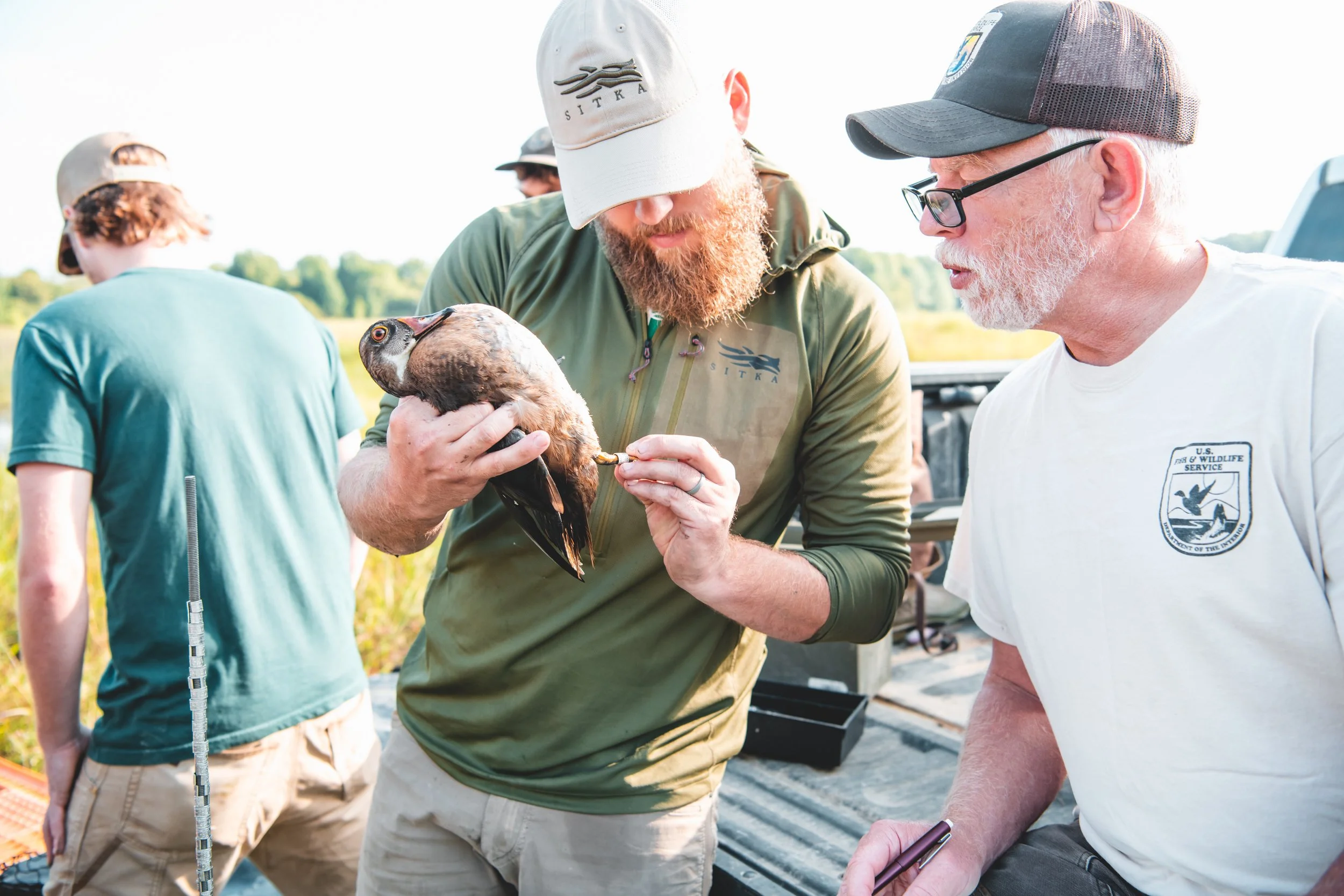Knowledge is Power: Waterfowl Research
Shawn Swearingen for SPLIT REED
Photos Courtesy of Ryan Askren
Waterfowlers truly enjoy putting special trinkets of metal on our lanyards that we are lucky enough to find on ducks or geese that we have taken. But what is behind the numbers on the bands? Each year in August, with the exception of Covid, the United States Fish & Wildlife Service (USFWS) releases the waterfowl population numbers and surveys. Who is compiling that information and doing the counts? All of these biologists and researchers started their schooling somewhere.
Dr. Ryan Askren is the Director at Five Oaks Ag Research and Education Center (FOAgREC) based in Arkansas. Part of his role as Director is working with students to develop young waterfowl and wetland professionals through the graduate certificate program. This program helps bridge the gap for students between undergraduate education, where students receive a great basis in the natural resource sciences but are often deficient in the land management side of things, and jobs in the ‘real world’ as land managers for government and private organizations.
“Our goal is to produce young professionals that not only have the knowledge to justify management actions but the ability to hop on a tractor and actually go do that action. We want to improve the landscape for waterfowl by training disciples of quality waterfowl habitat management,” said Dr. Askren.
Funding for these graduate certificate programs is possible thanks to graduate scholarships funded by a grant from Sitka Gear. The hands-on work that this program provides, coupled with ongoing research at Five Oaks, is improving our understanding of waterfowl management, including waterfowl use related to different management practices and the influence of hunting disturbance on waterfowl movement.
Dr. Heath Hagy of the United States Fish and Wildlife Service, Habitat and Population Evaluation Team, commented, “In the 20 years since I began graduate school to pursue a career as a waterfowl professional, it’s amazing how geospatial technologies and remote sensing information availability has changed. Today, it’s critical to have students trained in using the latest software to model current resource distribution at the landscape scale. At the same time, these same students need to be able to quickly gain field experience working on and around heavy equipment. It seems like some of the classic needs for field experience using heavy equipment, prescribed burning, and forestry practices have remained the same, but now we are asking individuals to simultaneously be proficient in many forms of geospatial analysis.”
Research that pushes the waterfowl community’s knowledge forward comes from the projects of hardworking graduate studies students undertake. Ducks Unlimited publishes these International Science Reports, ongoing projects, and a list of work they are supporting on their website.
“Each year there are roughly 100 projects that Ducks Unlimited is involved with or supports,” said Dr. Mike Brasher, Senior Waterfowl Scientist for Ducks Unlimited. “Staff in the U.S. and with DU Canada award eight fellowships each year to help fund this work.”
Many people get into the waterfowl biology and sciences profession because they have a love and appreciation for the outdoors and waterfowl, and sometimes that appreciation comes through hunting. As Dr. Brasher commented, “From Ducks Unlimited and our partners at state and federal agencies' perspectives, we are finding it important to actively communicate about this profession and recruit students to this as a potential career.” Early on, it was easier to recruit for the graduate and study programs when students grew up closer in contact with hunting. With the changing population centers and demographics, it takes active communication and recruitment for students. As hunters, we want to perpetuate waterfowl populations for future enjoyment; and, in order to ensure that it continues, it takes people who are passionate about waterfowl, the resources, and habitats as biologists and waterfowl scientists.
“The USFWS has a number of programs to help attract and train current students. The Directorate Fellows Program (DFP) is our direct-hire program to increase diversity among our staff. Candidates receive direct-hire authority for 2 years after successfully completing a rigorous 11-week paid fellowship and their related college or graduate degree requirements. Fellowship opportunities are available in biological science, natural resource management, outreach, and urban conservation, information technology, conservation law enforcement, and related fields. The Pathways Program offers federal internship, fellowship, and employment opportunities with the U.S. Fish and Wildlife Service. A more comprehensive list can be found here: https://www.fws.gov/internships.”, said Dr. Hagy.
Perpetuating waterfowl and necessary habitat for future generations does not happen without the scientists, ecologists, and land managers that have the passion and knowledge to do so. Having programs and the work like FOAgREC and others are doing along with the fellowships from Ducks Unlimited help make it happen, and I hope to be interviewing those that have the passion now as scientists and biologists in years to come thanks to those programs.
For more Split Reed Original Content click here.





